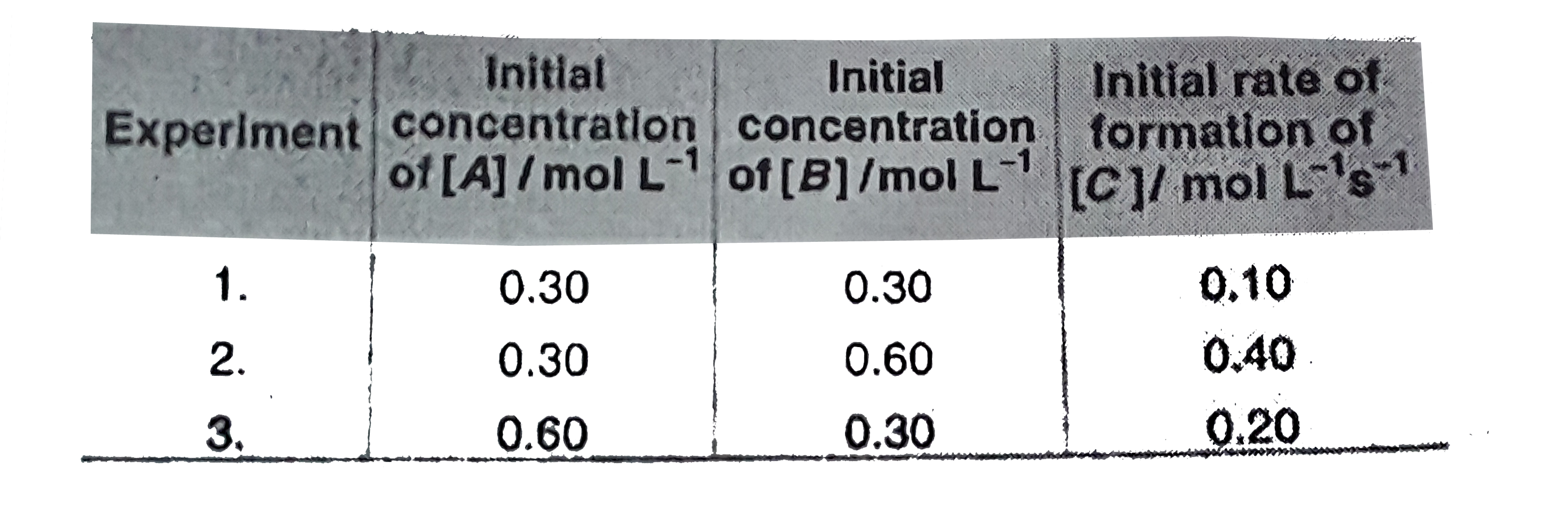Compound 'A' and B react according to the following chemical equation.
A(g)+2B(g)→2C(g)
Concentration of either A or B were changed keeping the concentrations of one of the reactants constant and rates were mesured as a function of initial concentration. Following results were obtained. Choose the correct option for the rate equations for this reaction.
ExperimentInitial concentration of[A]/molL−1Initial concentration of[B]molL−1Initial rate of formation of[c]/molL−1s−110.300.300.1020.300.600.4030.600.300.20
Rate =k[A]2[B]
Rate =k[A][B]2
Rate =k[A][B]
Rate = k[A]2[B]0
The correct Answer is:B
Let order with respect to A and B are x and y respectively.
∴ Rate = k(A)x(B)y
0.1=k(0.3)x(0.3)y
0.4=k(0.3)x(0.6)y
0.2=k(0.6)x(0.3)y
0.40.1=(0.6)y(0.3)y
∴y=1
Dividing (iii) by (i) 0.20.1=(0.6)x(0.3)x
∴x=1
Rate law will be:
Rate =k[A]1[B]2
Topper's Solved these Questions
- BOOK - NCERT FINGERTIPSCHAPTER - CHEMICAL KINETICSEXERCISE - Assertion And Reason15videos
CHEMICAL KINETICS
- BOOK - NCERT FINGERTIPSCHAPTER - CHEMICAL KINETICSEXERCISE - Higher Order Thinking Skills9videos
CHEMICAL KINETICS
- BOOK - NCERT FINGERTIPSCHAPTER - BIOMOLECULESEXERCISE - Assertion And Reason15videos
BIOMOLECULES
- BOOK - NCERT FINGERTIPSCHAPTER - CHEMISTRY IN EVERYDAY LIFE EXERCISE - Assertion And Reason15videos
CHEMISTRY IN EVERYDAY LIFE
Similar Questions
For the reaction A+B→C+D, doubling the concentration of both the reactants increases the reaction rate by 8 times and doubling the initial concentration of only B ismply doubles the reaction rate. What is the rate law for the reaction ?
View SolutionFor the reaction A+B→ Products, the following initial rates were obtained at various given initial concentrations.
 ltrbgt Write rate law and find the rate constant for the above reaction. View Solution
ltrbgt Write rate law and find the rate constant for the above reaction. View Solution
Knowledge Check
- Question 1 - Select One
Compounds 'A' and 'B' react according to the following chemical equation
A(g)+2B(g)→2C(g)
Concentration of either 'A' or 'B' were changed keeping the concentrations of one of the reactants constant and rates were measured as a function of initial concentration. Following results were obtained. Choose the correct option for the rate of equations for this reaction.
 ARate of = k[A]2[B]BRate = k[A][B]2CRate = k[A][B]DRate = k[A]2[B]−
ARate of = k[A]2[B]BRate = k[A][B]2CRate = k[A][B]DRate = k[A]2[B]− - Question 2 - Select One
Compounds 'A' and 'B' react according to the following chemical equation.
A(g)→2B(g)→2C(g)
Concentration of either 'A' or 'B' were changed Keeping the concentration of one of the reactants constant and rates were measured as a function of initial concentration. Following result were obtained.
Choose the correct option for the rate equations for this reaction.
 ARate =K[A]2[B]BRate =K[A][B]2CRate =K[A][B]DRate =K[A]2[B]0
ARate =K[A]2[B]BRate =K[A][B]2CRate =K[A][B]DRate =K[A]2[B]0 - Question 3 - Select One
Compounds A and B react according to the following chemical equation :
A(g)+2B(g)→2C(g)
Concentration of either A or B were changed keeping the concentrations of one of the reactant constants and rates were measured as a function of initial concentration, Following results were obtained.

Choose the correct option for the rate equations for this reaction.ARate = k[A]2[B]BRate = k[A][B]2CRate = k[A][B]DRate = k[A]2[B]0
Compounds A and B react according to the following chemical equation :
A(g)+2B(g)→2C(g)
Concentration of either A or B were changed keeping the concentrations of one of the reactant constants and rates were measured as a function of initial concentration, Following results were obtained.

Choose the correct option for the rate equations for this reaction.View SolutionFor a reaction 2A+B→2AB , it is found that doubling the concentration of both the reactants increases the rate to eight times that of initial rate but doubling the concentration of B alone doubles the rate. Then the order of the reaction with respect to A and B is
View SolutionIn a reaction A + B → Products
(i) If the initial concentration of A is doubled and B is kept constant, the rate of the reaction is doubled
(ii) If the initial concentration both A and B are doubled the rate of reaction becomes eight times
The rate law of the reaction is :View SolutionCo =initial concentration of the reactant Ct = concentration of the reactant at time t, k=rate constant of the reaction. Then the equation applicable for a first order reaction is
View SolutionThe rate constant for a first order reaction is equal to the initial rate of reaction when the initial concentration of the reactant is
View Solution

